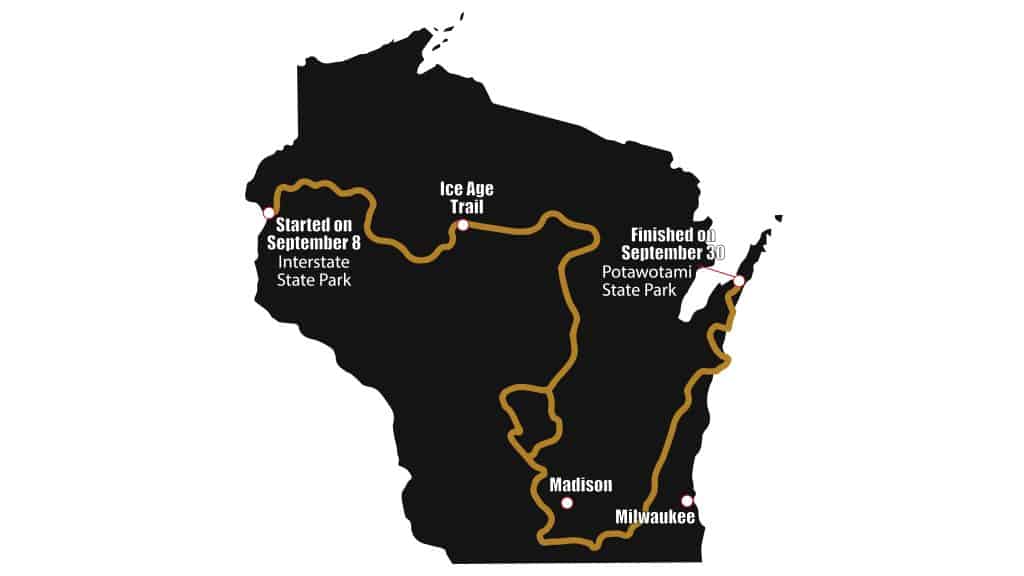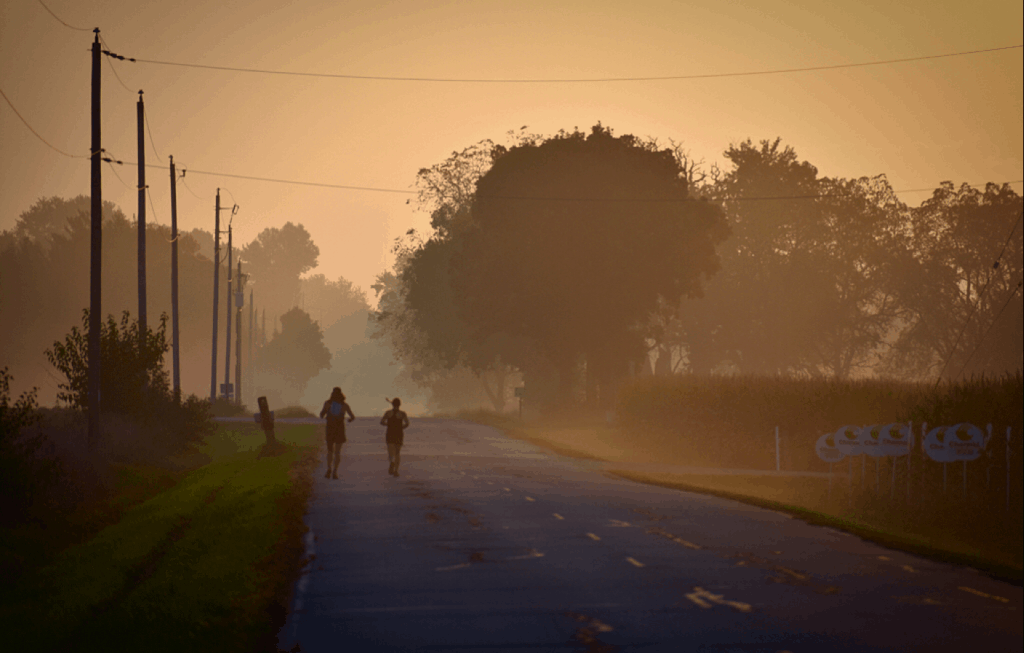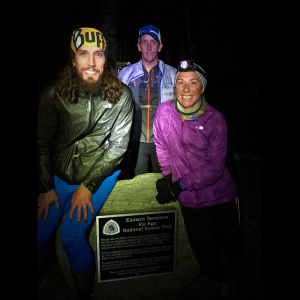
This past September, Annie Weiss, at the age of 33, ran 1,200 miles, the entirety of the Ice Age Trail, in 21 days—a record-breaking accomplishment. And not just once, she failed the first time and then ran it again at the fastest time ever, for any man or woman. Challenge motivates Annie. In fact, the first time she ran the Ice Age Trail she caught a bacterial infection in both her legs, which forced her to quit the race. She tried to continue for about two days but decided that the best option was to get the medical attention she needed. This failure encouraged Annie to try the race a second time.
Annie knew that if she did not complete this challenge she would be disappointed in herself. To stay motivated she reminds herself, “When starting something, you have to finish. When deciding to give up, you should always remind yourself [of] the feeling you’ll get when finishing.”
Annie has been running for 10 years, “I started running because a half-marathon was on my bucket list. So why not start sooner rather than later?” One day she went outside for a run and never stopped. She started racing and placing, then thought, “Wow, maybe I could be good at this?”

Failure Is Not in Annie’s Vocabulary
During her second try, no thoughts of failure crossed her mind. Of course, the “what-ifs” came and went, but Annie knew, “You have to live in the present. [It’s] this time or it’s no time.” Mental training is important for this type of challenge. To Annie, being positive is crucial for sticking to your goals, and that is exactly what she did throughout her race. Annie knew emotional roller coasters would happen during her challenge, so to stay in a positive mindset she would, “take one day at a time” and took any support she could get.
“I was pretty positive throughout the whole endeavor. What helped me was to focus on the present. We had a spreadsheet that mapped out our day. When you only focus on that one day and then crossing it out was very motivating. And just having people around helped,” explained Annie. Throughout the 21 days, her husband would either drive in their truck or run with her. The other days she had friends join her. Some of her friends would come out for two miles or 70 miles, “having someone around will allow you to keep a positive mind,” says Annie.

Annie Weiss and her husband running alongside each other
Annie believes support is different for everyone, “Support is huge. I enjoy training by myself because that helps me mentally, but there are huge benefits to training with people because they can push you and they can motivate you. So support, in whatever form it may be, is huge.”
“I was pretty positive throughout the whole endeavor. What helped me was to focus on the present. We had a spreadsheet that mapped out our day. When you only focus on that one day and then crossing it out was very motivating. And just having people around helped.”
Elite Plays a Major Role in Annie’s Life
Annie has been a member at Elite Sports Clubs for over 25 years and has worked at Elite Sports Clubs since 2003. Annie was in SCAMP when she was a kid and is now a Group Exercise Instructor. Elite Sports Clubs has supported Annie emotionally and physically. Annie would receive encouragement from the people who took her classes and she utilized Elite Sports Clubs’ resources for training.
Physically, Elite Sports Clubs supported Annie because “It’s my treadmill. You know, I go to the same treadmill, I talk to the same people. Everything I have here suited my needs for training.” Emotionally, Elite has been there for Annie as well. “My BodyPump class had a little party after my challenge. They were following along and reading the blog. Just being involved by being a Group Exercise Instructor, you form those friendships and relationships with people who become invested in what you’re doing.”
Conquer Your Fears and Keep Going
A lot of people run segments of the Ice Age Trail, but to put it all together is a big endeavor. When Annie attempted the route in 2017 and didn’t finish it, “that was sitting on my shoulders for a year, just hanging there, like, ‘You didn’t finish. You need to go back and finish it.’” For Annie, “it could be the Ice Age Trail, could be a race, could be anything, I just want to set a goal and finish it.”
Annie had a big challenge to complete and finding that motivation is crucial. “You have to find what motivates you. Some people are motivated by a single event, some are motivated by aesthetically what they see around them. I am motivated by a challenge.” It requires a certain mental toughness to keep going. “When things get really hard or youmentally want to stop, quit, walk, whatever it might be, always remind yourself of the feeling you get when you finish. And ask yourself how will I feel about quitting two days from now, or a week from now?” In Arizona, during a past race, Annie had fallen behind due to an infection and had to quit. She thought to herself, “what if I would have stuck with that?” Nevertheless, Annie knew at that point she had to quit to treat her medical condition. Annie continues to explain that when people are feeling discomfort in their legs, their breathing, they want to walk,“is that something you should really quit for? Always remind yourself, ‘What will I think in three days?’ ”
“You have to find what motivates you. Some people are motivated by a single event, some are motivated by aesthetically what they see around them. I am motivated by a challenge.”
Preparation
Annie prepared herself for the Ice Age Trail by training mainly on a treadmill for the first attempt and only outdoors for the second attempt. Annie trained for two months for the Ice Age Trail and ran 50 miles per day. She ran a 100-mile race before the Ice Age Trail, so she has had previous experience with ultra-marathon racing. “Now, I already have a pretty solid base. I would not [recommend] someone who runs 20 miles a week [to] jump to this level.”
“When training for the Ice Age Trail, it is all mental,” says Annie. Part of her preparation included running an eight-hour loop on repeat. Repeating the process prepares your mind and your body for such an intense challenge. “It is all about the repeat. Repeating prepares you, enjoy the repeat. Running on repeat around the same loop will train your mind to remain focused. When running the trail, you are running on a paved road for miles, then onto a trail for miles. You can easily get bored and possibly stop running from the lack of mental training,” explains Annie. The challenges Annie sets herself up for require more mental training than physical training. “With something like this, it is more mental. It’s all in your head. Being physically prepared is still important, but it’s really a mentality.”
“It takes a lot because you have to be able to work through mental pain, physical pain, and emotional pain—I mean everything,” Annie explains. She also described the importance of periodization. In her case, she trained, then raced, took recovery time, then trained again. Periodization allows your body to recover properly and then get right back to business. The three months Annie took off was her recovery time. Annie was running comfortably 10 to 15 miles per week a few weeks after the challenge was complete. She continued to have two sessions a week training at Elite with her personal trainer, Jen, while still allowing for recovery time.
What comes with preparation is research. “It is important to always do your research and to be prepared before any goal,” says Annie. In her case, they did not prepare for a tornado. While she was running on Day 20 out of the 21 days, she was held back from tornado damage. Annie wished that she had done more research to prevent having to navigate that particular type of obstacle. Nevertheless, on Day 21 she persisted. Annie emphasizes that you should, “have a really strong foundation or skeleton of all of the logistics. You cannot go in and say I am going to run 50 miles a day and that is that. Planning for recovery and training will make your goal-setting easier.”
When Do You Know to Decide What’s Next?
Annie described her feeling after finishing the challenge as “surreal.” She started at the western terminus and ended at the eastern terminus, “which is essentially a rock,” explained Annie. She described her finishing moment: “I kind of like stood there and it was like, ‘Now what? Do we turn around and go back?’”

Annie Weiss with her support system at the Eastern Terminus
This was a moment of, “I can’t believe it’s over. 21 days repeating you wake up, you eat, you run, you sleep, you eat, you run, you eat, you sleep, you eat, you run. A constant repetition of the same thing. Similar to someone’s work-life repetition, just a more uncomfortable routine.” When it ended, Annie and her husband had no idea what to do with themselves. They arrived back at home at 5 o’clock in the morning after finishing the challenge just a few hours earlier at 1 o’clock, “Literally we sat there and had no idea. It was really foreign to us to not be out there running.”
Annie described this change as “hard.” Her husband went back to work while Annie had more time off. She felt great about herself but also uncomfortable because she wasn’t running. Annie says the Ice Age Trail accomplishment is not the end of her journey. She plans on moving forward on to other challenges. Also, the only way she would ever race in the Ice Age Trail again is if someone were to beat her record. She started training again on January 7th.
Annie will be running the Arizona Trail in the Spring of 2020, the CCC Alps: France-Italy Race, a 100k race through the Alps, circling Mount Blanc and crossing portions of France, Italy, and Switzerland. She was also invited to the Ultra Race of Champions (100K race). Annie is considering competing in Badwater 135 as well, a 135-mile run across Death Valley in July. When setting goals, Annie encourages herself and others to “stay in the present and ask yourself if you are putting in your best effort.”
This article appeared in the 2019 Summer Edition of Elite Life Magazine